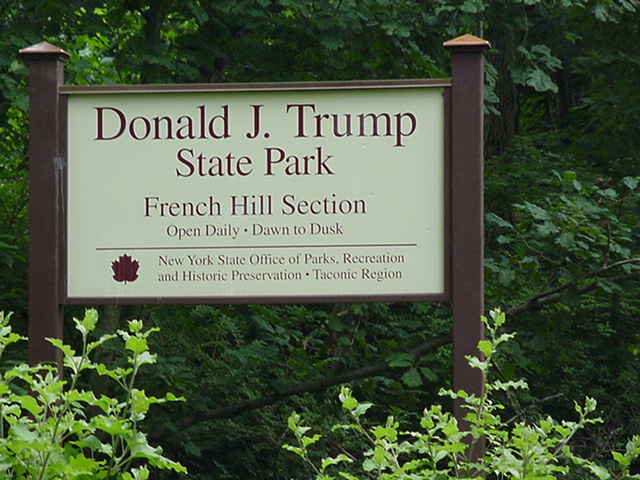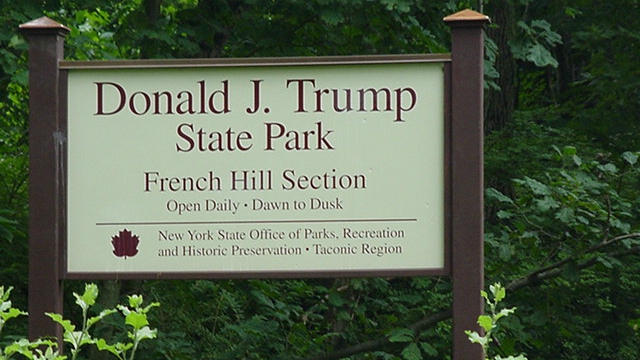One of the odder features of New York state’s highway system is the presence of several large signs along the Taconic State Parkway in Westchester County advertising a “Donald J. Trump State Park.” Why would the great, liberal state of New York name a park after a xenophobic real estate developer and reality TV star?
As I reported in September, it’s because Trump’s schemes for the land were foiled and so giving it to the state in exchange for a tax deduction was his last resort. As with every problem in 2016, there are multiple online petitions calling for solutions. The first one, launched many months ago, just demanded the state give the park a new name — any new name. It currently has 2,700 signatures.
But some inspired progressive came up with the ultimate rebuke to Trump and all that he stands for: They want to rename the park after Pete Seeger. Seeger, as you surely know if you are an over-60 ex-hippie or were raised by one, was a legendary left-wing folk singer. As you probably don’t know unless you live in New York, Seeger spent much of his life in Westchester — the suburban county just north of New York City — where Trump Park is located. And he played a major role in cleaning up the Hudson River that forms its western border.
When Seeger died two years ago, Grist reprinted a blog post by Michelle Nijhuis about growing up in the area and the lasting impact Seeger had made there. Here are some key excerpts:
At the time the Seegers arrived [in Beacon, N.Y.], the Hudson River was dirty. Well, it was filthy. Almost anyone could dump almost anything into the river, no permit required: sewage, garbage, industrial waste in all its awful variety. Bacteria consumed so much oxygen that fish sometimes suffocated in the water …
So Pete ordered up a big wooden boat. Which, at first, made sense to just about nobody. But Pete thought that a graceful, old-fashioned boat — a replica of the sloops that sailed the river in the 18th and 19th centuries — would draw people to their forgotten riverfronts, and that from the riverfronts they could imagine a different future for the Hudson …
The tall-masted sloop was hard to ignore, and so were Pete and his banjo. People did come to the broken-down riverfronts, and they did start to make noise, and the attention Pete and his allies drew to the deplorable state of the Hudson eventually contributed to the passage of the federal Clean Water Act in 1972. (While Congress debated the law, Pete pressed his case by sailing the Clearwater sloop to D.C. and holding an impromptu concert in the halls of Congress — which may or may not have helped.) The Clean Water Act regulated discharge and funded sewage treatment, and bit by bit the Hudson got cleaner …
The sloop kept sailing, and Pete kept playing, and when I was a kid in the Hudson Valley, in the 1970s and 80s, it was almost impossible to avoid the Clearwater sloop and its creator. Pete didn’t cloister himself like most celebrities, but played in classrooms and at festivals and everywhere in between …
He fought for for the cleanup of PCBs and other legacy pollutants in the Hudson. When he died, at 94, he was championing an initiative to build river pools on the Beacon waterfront reminiscent of the wooden swimming platforms that floated off Manhattan in the 1900s.
Being a Seeger fan is practically shorthand for “flower grandparent.” As my dad said when taking me to a Seeger concert some 20 years ago and looking for the entrance, “Just follow the gray ponytail.” Change.org, on the other hand, is everyone’s idea of a millennial hub. Even so, a Change.org petition to rename the park Pete Seeger State Park launched this week. It acquired more than 3,000 supporters within its first two days. It seems that people, especially the idealistic young, want something to be for, not just something to be against, even if the thing they are for is an old white guy. (Just ask Bernie Sanders.)
As one signatory put it in an extremely understated comment contrasting the two men, “Pete Seeger has contributed far more to this area for conservation and there is no better representative of stewarding the forest than him. Donald Trump does not have the same goals.”
Seeger was a famously modest person, the very antithesis of Trump, and so one might question whether he’d even want a park named after him. But his family is supportive. “Although Grandpa would find this ridiculous, I am all for people remembering Grandpa when they are enjoying the outdoors,” wrote Seeger’s grandson Kitama on Seeger’s Facebook page.
There is another problem, though: the park isn’t even much of a park. Like its namesake, it promises far more than it delivers. I explained in September:
In the 1990s, Trump bought a swath of land in two Westchester towns in the hopes of developing a golf course … The towns rejected Trump’s proposal … and in 2006 he donated the land to the state. As sometimes happens when rich people give their property to the public, the park was named after Trump …
Trump, unlike many other super-rich park benefactors, did not make a donation to create a private endowment to help with upkeep of the park. He did, however, receive a tax deduction for donating the land. The state added big signs to the adjacent highway advertising a park that was envisioned as having parking, hiking trails, and picnic tables. Those never materialized.
Then the Great Recession hit and the state parks budget fell under the axe. Trump Park, not exactly one of the crown jewels of the state park system, was closed altogether …
After five years of neglect, it has deteriorated and become overgrown. The crumbling buildings are covered in graffiti, the paths hidden by brush …
And yet the state Department of Transportation has neglected to remove the road signs pointing to the park.
While Seeger is the best possible person to honor with a park in Westchester, he deserves a park that’s actually a functioning park. The solution would be for supporters of Seeger Park to raise money for its renovation and maintenance and offer it to the state in exchange for the name change. In the meantime, the state Department of Transportation should finally find the time to take down the signs for a Trump Park that doesn’t even exist.



